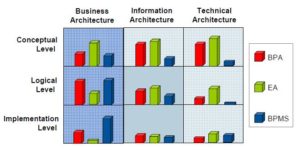Jim Sinur led a session this morning on dynamic BPM and how to deal with the demands for change. He started with the statement that dynamic BPM is more than just another type of BPM technology, it’s a requirement for a transformational advantage, and took a look at how BPM will become more dynamic in the future.
Change is driven by unexpected exceptions in processes, and patterns of these unexpected events can indicate trends in your business environment that the processes need to accommodate. Typical change cycles in IT, however, tend to be slow and steady, which doesn’t at all match either the business dynamics or the external forces that shape them. Being able to handle these spiky demands drives the requirement for more dynamism in how processes and rules are managed, and drives the requirement for the business to be able to manage these directly rather than having to engage IT for all changes.
Gartner’s definition of dynamic BPM is the ability to support process change by any role, at any time, with very low latency. Change agents include everyone from customers and business people through business and process analysts, and on to architects and developers; if the people at the business end of this spectrum aren’t allowed to make process changes, then they’ll just work around it and invent their own processes using their own tools. This isn’t just about each individual’s personal preferences for how they work, however: if knowledge workers can make changes to their processes, they will tend to make them more efficient and effective, which has enterprise benefits.
A significant part of this is the inclusion of explicit rules within processes, so that scenario-driven rule sets can detect and respond to conditions, even without the process participants having to make those changes themselves: the basis of what James Taylor was saying in his presentation this morning. What used to be monolithic lumps of code can be split into several parts, each of which has the potential to be agile: user interface is managed by portals and the web; decision points are handled by rules engines; paths of execution are managed by BPMS; and data definitions are handled in databases or XML data representations. All of those parts used to be under the control of the developers, but turning it inside out and using more agile technologies allows people to customize their UI, change their rules on a daily basis, modify their processes, and define their own data structures. Dynamic BPM isn’t just about changing process models, it spans requirements, recompilation, data binding, loading and versioning.
There was quite a bit about services composition environments and CEP that I felt didn’t really belong in a presentation on dynamic BPM: yes, you need to have services and CEP in order to build agile processes in the first place, but it seems like filler.
One brief slide on “Web 2.0”, really just a quick laundry list of enterprise social software aspects that could impact BPM, including collaborative process design and execution, but no meat. Sinur merely read the list and pointed out that there are vendors at the showcase showing some of these capabilities. That was a bit of a disappointment, considering that the term “dynamic BPM” is being used by many (including Forrester and several vendors) to describe collaborative processes that are created or modified at runtime by the user.
He finished up with some sensible advice about separating rules and other application components from the processes in order to push towards more agile processes, although not different from the message that we’ve been hearing for quite a while now.
This wasn’t a new presentation: it was mostly recycled material that I had seen in previous Gartner presentations (either at conferences or on webinars) about agile BPM using rules, services and complex event processing. There’s been some new verbiage put around it and a few new slides, but only the briefest nod to the type of user-created ad hoc collaborative processes that represent the most dynamic form of BPM.


